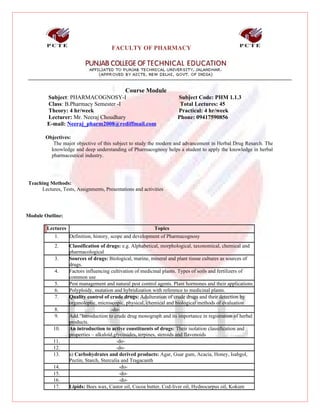
Pharmacognosy ist sem
- 1. FACULTY OF PHARMACY Course Module Subject: PHARMACOGNOSY-I Subject Code: PHM 1.1.3 Class: B.Pharmacy Semester -I Total Lectures: 45 Theory: 4 hr/week Practical: 4 hr/week Lecturer: Mr. Neeraj Choudhary Phone: 09417590856 E-mail: Neeraj_pharm2008@rediffmail.com Objectives: The major objective of this subject to study the modern and advancement in Herbal Drug Resarch. The knowledge and deep understanding of Pharmacognosy helps a student to apply the knowledge in herbal pharmaceutical industry. Teaching Methods: Lectures, Tests, Assignments, Presentations and activities Module Outline: Lectures Topics 1. Definition, history, scope and development of Pharmacognosy 2. Classification of drugs: e.g. Alphabetical, morphological, taxonomical, chemical and pharmacological 3. Sources of drugs: Biological, marine, mineral and plant tissue cultures as sources of drugs. 4. Factors influencing cultivation of medicinal plants. Types of soils and fertilizers of common use 5. Pest management and natural pest control agents. Plant hormones and their applications 6. Polyploidy, mutation and hybridization with reference to medicinal plants. 7. Quality control of crude drugs: Adulteration of crude drugs and their detection by organoleptic, microscopic, physical, chemical and biological methods of evaluation 8. -do- 9. Add.”Introduction to crude drug monograph and its importance in registration of herbal products. 10. An introduction to active constituents of drugs: Their isolation classification and properties – alkaloid,glycosides, terpines, steroids and flavonoids 11. -do- 12. -do- 13. a) Carbohydrates and derived products: Agar, Guar gum, Acacia, Honey, Isabgol, Pectin, Starch, Sterculia and Tragacanth 14. -do- 15. -do- 16. -do- 17. Lipids: Bees wax, Castor oil, Cocoa butter, Cod-liver oil, Hydnocarpus oil, Kokum
- 2. butter, Lard, Linseed oil, Rice-bran oil, shark liver oil and wool fat 18. -do- 19. -do- 20. -do- 21. -do- 22. Apocynacae 23. Solanaceae 24. Rutaceae 25. Umbelliferae 26. Leguminosae 27. Rubiaceae 28. Liliaceae 29. Graminae 30. Libiatae 31. Cruciferae, Papaveraceae 32. Plant Cell: Its structure and non-living inclusions; mitosis and meiosis; different types of plant tissues and their functions. Morphology and histology of root, stem, bark, wood, leaf, flower, fruit and seed. Modification of root and stem. 33. -do- 34. -do- 35. -do- Modes of Assessment: Modes of Assessment Score Assignment 10 Presentation 10 Mid semester exam 40 st 1 Hourly test 20 2nd Hourly test 20 Total marks 100 Books Recommended 1. Trease, G. E. and Evans, W.C. Pharmacognosy, Published by Elsevier, a Division of Reed Elsevier India Pvt. Ltd., New Delhi. 2. Kokate, C.K., Purohit, A.P. and Gokhale, S.B Pharmacognosy, Nirali Prakashan, Pune. 3. Handa, S.S and Kapoor, V.K. Textbook of Pharmacognosy, Vallabh Prashan, New Delhi. 4. Medicinal Plants of India. ICMR, New Delhi. 5. Wallis, T.E. Textbook of Pharmacognosy, Fifth Edition, CBS Publishers and Distributors, New Delhi. 6. Tyler, V.C., Brady, L.R. and Robers, J.E. Pharmacognosy. Lea & Febiger, Philadelphia.
- 3. Topics for Presentation & Assignments Classification of drugs: e.g. Alphabetical, Lipids: Bees wax, Castor oil, Cocoa butter, morphological, taxonomical, chemical and Cod-liver oil, Hydnocarpus oil, Kokum butter, pharmacological Lard, Linseed oil, Rice-bran oil, shark liver oil and wool fat Sources of drugs: Biological, marine, Quality control of crude drugs: Adulteration mineral and plant tissue cultures as sources of crude drugs and their detection by of drugs. organoleptic, microscopic, physical, chemical and biological methods of evaluation Factors influencing cultivation of medicinal Solanaceae plants. Types of soils and fertilizers of common use Pest management and natural pest control Rutaceae agents. Plant hormones and their applications Polyploidy, mutation and hybridization with Umbelliferae reference to medicinal plants. Plant Cell: Its structure and non-living Leguminosae inclusions; mitosis and meiosis; different types of plant tissues and their functions. Morphology and histology of root, stem, bark, wood, leaf, flower, fruit and seed. Modification of root and stem Carbohydrates and derived products: Rubiaceae Agar, Guar gum, Acacia, Honey, Isabgol, Pectin, Starch, Sterculia and Tragacanth Graminae Liliaceae
- 4. Pharmacognosy Practical S.No. Name of experiment 1 To discuss introductory aspects of Pharmacognosy. 2 To study and discuss various parts of simple and compound microscope. 3 To perform various identification tests for carbohydrate. 4 To perform various identification test for oils and fats. 5 To perform various identification tests for given carbohydrate. i Starch ii Acacia 6 To perform various identification tests for lipids (castor oil and shark liver oil) 7 To perform chemical identification tests for given sample of lipids. i Honey ii Yellow Bees-wax 8 To identify physically and chemically the given sample of Agar and gelatin. 9 To study the morphological characters of the given sample of Isabgol. 10 To study the macroscopic characters of olive oil and castor oil. Instruction for students: 1. Assignment must neatly presented 2. Late submission is not permissible and will attract minimum awards. 3. Presentation is compulsory 4. Each group is assigned different subject for the presentation day. 5. The presentation day attendance is equivalent to 4 lectures. 6. The synopsis must be submitted one week before the presentation. 7. 75% attendance is mandatory, below this percentage; student will not be allowed to appear in the examination. 8. The student will record the details of practicals in the practical note book and get it checked every time from the instructor after the experiment has been completed.